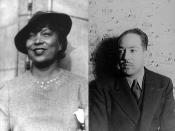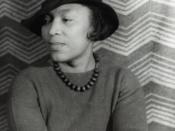The Harlem Renaissance initiated a cultural awakening or blossoming of music, art, and literature among the African American community. Their voice, so to speak, was heard around the world especially throughout the United States. Furthermore, many of the creative short stories are still very influential to this day. Two popular short stories from writers of that era are Zora Neale Hurston's "Sweat" and Richard Wright's "Big Black Good Man." Although, both reveal the struggles of African Americans during the early to mid-twentieth century, Hurston and Wright approach their stories with a different objective and style, which can be examined by analyzing the plot and technique.
First, Zora Neale Hurston becomes an influence among the African American literary community by writing about their own culture using a fairly new technique. Unlike many of the other Harlem Renaissance writers, she does not dwell on racism. Rather, she presents a picture of her culture.
Hurston stamps her short story "Sweat" with the African American identity. She accomplishes this through the dialect, town's people, and Delia's lifestyle. Hurston's characters speak using the common dialect of her race. "Even in her earliest fiction, she recognized that the poetry of black folk speech might be the foundation of a new literature" (Wall 4). In "Sweat," the townspeople sit and discuss Delia and Sykes. They dislike the antagonist, Sykes, and feel sympathy for the protagonist, Delia. " 'Sykes Jones ain't wuth de sot an' powder hit would tek tuh kill 'em.' "(Wall 30). However, wives during this era belong to their husbands so nothing is said or done to Sykes. As Joe Clarke, one of the villagers, states, " 'Tain't no law on earth dat kin make a man be decent if it ain't in 'im' " (Wall 31). Delia works for survival doing white folk's...


